
Alstroemeria, commonly called the Peruvian lily or lily of the Incas, is a genus of flowering plants in the family Alstroemeriaceae. They are all native to South America although some have become naturalized in the United States, Mexico, Australia, New Zealand, Madeira and the Canary Islands. Almost all of the species are restricted to one of two distinct centers of diversity, one in central Chile, the other in eastern Brazil. Species of Alstroemeria from Chile are winter-growing plants while those of Brazil are summer-growing. All are long-lived perennials except A. graminea, a diminutive annual from the Atacama Desert of Chile.
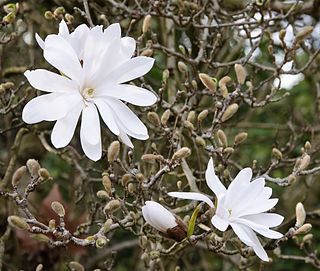
Magnolia stellata, sometimes called the star magnolia, is a slow-growing shrub or small tree native to Japan. It bears large, showy white or pink flowers in early spring, before its leaves open. This species is closely related to the Kobushi magnolia, and is treated by many botanists as a variety or even a cultivar of that. However, Magnolia stellata was accepted as a distinct species in the 1998 monograph by Hunt.

Impatiens walleriana, also known as busy Lizzie, balsam, sultana, or simply impatiens, is a species of the genus Impatiens, native to eastern Africa from Kenya to Mozambique. The Latin specific epithet walleriana honours a British missionary, Horace Waller (1833–1896).

Dasylirion wheeleri is a species of flowering plant in the asparagus family Asparagaceae, native to arid environments of northern Mexico, in Chihuahua and Sonora and in the southwestern United States, in the Sonoran Desert in Arizona, and also in New Mexico and Texas.

Primula elatior, the oxlip, is a species of flowering plant in the family Primulaceae, native to nutrient-poor and calcium-rich damp woods and meadows throughout Europe, with northern borders in Denmark and southern parts of Sweden, eastwards to the Altai Mountains and on the Kola Peninsula in Russia, and westwards in the British Isles.
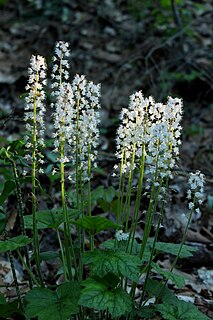
Tiarella cordifolia, the heartleaf foamflower, heartleaved foamflower, Allegheny foamflower, false miterwort, or coolwort, is a species of flowering plant in the saxifrage family, native to North America. It is a herbaceous perennial which is valued in cultivation for its erect stems of foamy cream flowers in summer.
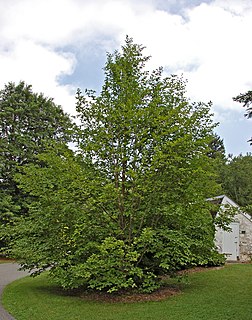
Stewartia pseudocamellia, also known as Korean stewartia, Japanese stewartia, or deciduous camellia, is a species of flowering plant in the family Theaceae, native to Japan and Korea.
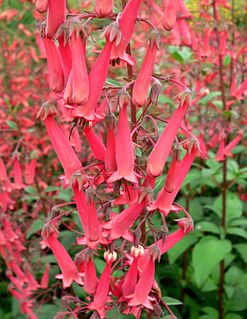
Phygelius capensis, the cape figwort or cape fuchsia, is a species of flowering plant in the family Scrophulariaceae, native to South Africa.

Tropaeolum majus, the garden nasturtium, nasturtium, Indian cress or monks cress, is a species of flowering plant in the family Tropaeolaceae, originating in the Andes from Bolivia north to Colombia. An easily-grown annual or short-lived perennial with disc-shaped leaves and brilliant orange or red flowers, it is of cultivated, probably hybrid origin. It is not closely related to the genus Nasturtium.

Plumbago auriculata, the cape leadwort, blue plumbago or Cape plumbago, is a species of flowering plant in the family Plumbaginaceae, native to South Africa.

Sorbus commixta, the Japanese rowan, is a species of flowering plant in the family Rosaceae, native to Japan, Sakhalin, and the Korean island of Ulleungdo.

Erysimum cheiri, syn. Cheiranthus cheiri, the wallflower, is a species of flowering plant in the family Brassicaceae (Cruciferae), native to Greece, but widespread as an introduced species elsewhere. It is also treated as a hybrid under the name Erysimum × cheiri. It is widely cultivated as a garden plant.
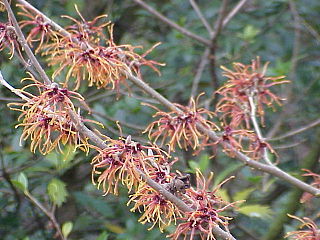
Hamamelis×intermedia, the hybrid witch hazel, is a flowering plant in the family Hamamelidaceae. It is a hybrid of garden origin between H. japonica and H. mollis. Its Latin name refers to its intermediate appearance between those two species.
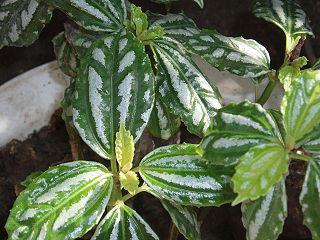
Pilea cadierei, the aluminium plant or watermelon pilea, is a species of flowering plant in the nettle family Urticaceae, native to China and Vietnam. The specific epithet cadierei refers to the 20th-century botanist R.P. Cadière. It has gained the Royal Horticultural Society's Award of Garden Merit.
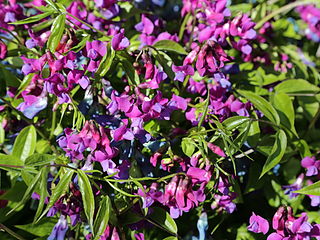
Lathyrus vernus, the spring vetchling, spring pea, or spring vetch, is a species of flowering herbaceous perennial plant in the genus Lathyrus, native to forests of Europe and Siberia. It forms a dense clump of pointed leaves with purple flowers in spring, shading to a greenish-blue with age.

Solanum crispum is a species of flowering plant in the family Solanaceae, native to Chile and Peru. Common names include Chilean potato vine, Chilean nightshade, Chilean potato tree and potato vine. Growing to 6 m (20 ft) tall, it is a semi-evergreen, woody-stemmed climbing plant. The small blue fragrant flowers, 2.5 cm in diameter, with prominent yellow ovaries, appear in clusters in summer. They resemble those of the closely related potato. Very small poisonous berries are produced in autumn. The berries start out green, then yellow-orange, and finally purple. The leaves are oval.

Lewisia brachycalyx is a species of flowering plant in the family Montiaceae, known by the common name short-sepal bitter-root or shortsepal lewisia. It is native to the mountains of the southwestern United States and Baja California, where it grows in moist habitat such as meadows. It is a deciduous perennial growing from a short thick taproot and caudex unit. It produces a basal rosette of thick, fleshy, blunt-tipped narrow leaves up to 8 centimeters long. The inflorescence is under 4 centimeters tall, taking the form of a cluster of several flowers sitting atop the leaf rosette. Each flower has 5 to 9 shiny white or pink petals about 2 centimeters long. At the center are many stamens and stigmas clumped together. The Latin specific epithet brachycalyx means “having a short calyx”.

Lewisiopsis tweedyi is a flowering plant and sole species in genus Lewisiopsis. The species, formerly known as Cistanthe tweedyi and Lewisia tweedyi, is now classified in the family Montiaceae. The plant is known by the common names Tweedy's pussypaws, Tweedy's lewisia, or Tweedy's bitterroot. It is endemic to western North America in north-central Washington and adjacent British Columbia. It commonly grows on well-drained slopes often on rocky slopes or in rock crevices from low elevation ponderosa pine sites up to the drier part of the Grand Fir zone of the North Cascades. The flowers usually have a coral, apricot, or pink color.

Thymus pulegioides, common names broad-leaved thyme or lemon thyme, is a species of flowering plant in the family Lamiaceae, native to Europe. Growing to 5–25 cm (2–10 in) tall by 25 cm (10 in) wide, it is a small spreading subshrub with strongly aromatic leaves, and lilac pink flowers in early summer. The specific epithet pulegioides highlights its similarity to another species within Lamiaceae, Mentha pulegium (pennyroyal).

Crassula ovata, commonly known as jade plant, lucky plant, money plant or money tree, is a succulent plant with small pink or white flowers that is native to the KwaZulu-Natal and Eastern Cape provinces of South Africa, and Mozambique; it is common as a houseplant worldwide. Much of its popularity stems from the low levels of care needed; the jade plant requires little water and can survive in most indoor conditions. It is sometimes referred to as the money tree; however, Pachira aquatica also has this nickname.




















